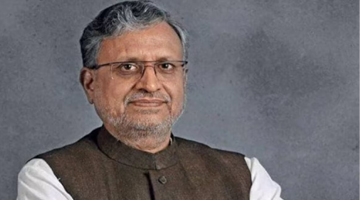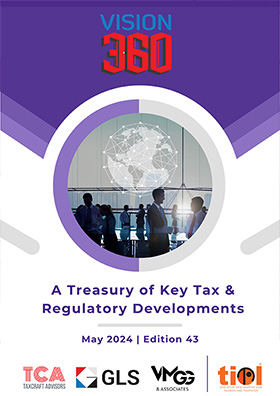GST mop-up grew by 4.1 % between April-November, 2019
By TIOL News Service
NEW DELHI, JAN 31, 2020: THE Government says that based on first Advance Estimates, India's GDP growth for 2019-20 would be recorded at 5 per cent. This suggests an uptick in GDP growth in second half of 2019-20. The Union Minister for Finance and Corporate Affairs, Nirmala Sitharaman tabled the Economic Survey 2019-20 in Parliament today, which states that the deceleration in GDP growth can be understood within the framework of a slowing cycle of growth. The financial sector has acted as a drag on the real sector.
The Survey says that the uptick in second half of 2019-20 would be mainly due to ten positive factors like picking up of NIFTY for the first time this year, an upbeat secondary market, higher FDI flows, build-up of demand pressure, positive outlook for rural consumption, rebound of industrial activity, steady improvement in manufacturing, growth in merchandize exports, higher build-up of foreign exchange reserves and positive growth rate of GST revenue collection.
The Survey says, on a net assessment of both the downside/upside risks, India's GDP growth is expected to grow in the range of 6.0 to 6.5 per cent in 2020-21 and it asks the Government to use its strong mandate to deliver expeditiously on reforms, which will enable the economy to strongly rebound in 2020-21.
The Survey points out that the year 2019 was a difficult year for the global economy with world output growth estimated to grow at its slowest pace of 2.9 per cent since the global financial crisis of 2009, declining from a subdued 3.6 per cent in 2018 and 3.8 per cent in 2017. Uncertainties, although declining, are still elevated due to protectionist tendencies of China and USA and rising USA-Iran geo-political tensions. Amidst a weak environment for global manufacturing, trade and demand, the Indian economy slowed down with GDP growth moderating to 4.8 per cent in first half of 2019-20, lower than 6.2 per cent in second half of 2018-19. A sharp decline in real fixed investment induced by a sluggish growth of real consumption has weighed down GDP growth from 2nd half of 2018-19 to 1st half of 2019-20.
Real consumption growth, however, has recovered in Q2 of 2019-20, cushioned by a significant growth in government final consumption. At the same time, India's external sector gained further stability in 1st half of 2019-20, with a narrowing of Current Account Deficit (CAD) as percentage of GDP from 2.1 in 2018-19 to 1.5 in 1st half of 2019-20, impressive Foreign Direct Investment (FDI), rebounding of portfolio flows and accretion of foreign exchange reserves. Imports have contracted more sharply than exports in 1st half of 2019-20, with easing of crude prices, which has mainly driven the narrowing of CAD.
On the supply side, agricultural growth, though weak, is moderately higher in 1st half of 2019-20 than in 2 nd half of 2018-19. Headline inflation rose from 3.3 per cent in 1st half of 2019-20 to 7.4 per cent in December 2019 on the back of temporary increase in food inflation, which is expected to decline by year end. Rise in CPI-core and WPI inflation in December 2019 suggests building of demand pressure.
In an attempt to boost demand, 2019-20 has witnessed significant easing of monetary policy with the repo rate having been cut by RBI by 110 basis points. Having duly recognized the financial stresses built up in the economy, the government has taken significant steps this year towards speeding up the insolvency resolution process under Insolvency and Bankruptcy Code (IBC) and easing of credit, particularly for the stressed real estate and Non-Banking Financial Companies (NBFCs) sectors. At the same time, impact of critical measures taken to boost investment, particularly under the National Infrastructure Pipeline, present green shoots for growth in H2 of 2019-20 and 2020-21.
Given India's record of growth with macroeconomic stability over the last five years (annual average growth rate of 7.5 per cent), the economy is poised for a rebound towards the US$ 5 trillion goal by 2024-25.The net FDI and Net Foreign Portfolio Investment (FPI) in first eight months of 2019-20 stood at US$ 24.4 billion and US$ 12.6 billion respectively, more than the inflows received in the corresponding period 2018-19.
In 1st half of 2019-20, CPI (Headline) inflation was estimated at 3.3 per cent, slightly higher than that in 2 nd half of the previous year. There has been a further uptick in headline inflation in the month of December 2019 to 7.35 per cent contributed mainly by supply side factors. The food prices spiked following unseasonable rainfall and a flood-like situation in many parts of the country, which affected agricultural crop production. The Wholesale Price Index (WPI) inflation, on the other hand, declined sharply from 3.2 per cent in April 2019 to 2.6 per cent in December 2019, reflecting weakening of demand pressure in the economy.
As per the latest available data on employment, there has been an increase in the share of formal employment, as captured by ‘Regular wage/salaried', from 17.9 per cent in 2011-12 to 22.8 per cent in 2017-18. This 5 per cent points increase in the share of ‘Regular wage/Salaried' group has been on account of 5 percentage points decrease in the share of casual workers, which reflects formalization in the economy. As a result, in absolute terms, there was a significant jump of around 2.62 crore new jobs over this period in the usual status category with 1.21 crore in rural areas and 1.39 crore in urban areas.
In 2019-20, Centre's fiscal deficit was budgeted at Rs. 7.04 lakh crore (3.3 per cent of GDP), as compared to Rs. 6.49 lakh crore (3.4 per cent of GDP) in 2018-19. Good and Services Tax (GST) collections, the biggest component of indirect taxes, grew by 4.1 per cent for the Centre during April-November 2019. However, the uptick in growth of cumulative GST collections for the Centre started in October 2019 and has sustained its momentum in November December 2019 as well.
The growth of bank credit which was picking up in 1st half of 2018-19, started decelerating in 2 nd half of 2018-19 and further in 1st half of 2019-20. The deceleration was witnessed across all major segments of non-food credit, save personal loans which continued to grow at a steady and robust pace. The deceleration in credit growth was most in the services sector. Credit growth to industry also witnessed a significant decline in recent months, both for MSME sector as well as large industries. Agriculture and allied activities benefitted from a higher growth of credit.
Despite muted growth of services exports, the trade balance on the services account continued to be positive in 2019-20. The trade surplus on services account has been estimated at US$ 40.5 billion in 1st half of 2019-20, as compared to US$ 38.9 billion in 2018-19.
Lower Current Account Deficit (CAD) reflects reduced external indebtedness of the country making domestic economic policy increasingly independent of external influence. The CAD, which was 2.1 per cent of GDP in 2018-19, has improved to 1.5 per cent in H1 of 2019-20 on the back of significant reduction in trade deficit. In the first eight months of 2019-20, both gross and net FDI flows to the country have been more than the flows received in corresponding period of 2018-19. Net FPI inflow in 1st half of 2019-20 was also robust at US$ 7.3 billion as against an outflow of US$ 7.9 billion in 1st half of 2018-19.
The drop in fixed investment by households from 14.3 per cent to 10.5 per cent explains most of the decline in overall fixed investment between2009-14 to 2014-19. Fixed investment in the public sector marginally decreased from 7.2 per cent of GDP to 7.1 per cent during the two periods. However, the stagnation in private corporate investment at approximately 11.5 per cent of GDP between 2011-12 to 2017-18 has a critical role to play in explaining the slowing cycle of growth and, in particular, the recent deceleration of GDP and consumption.














